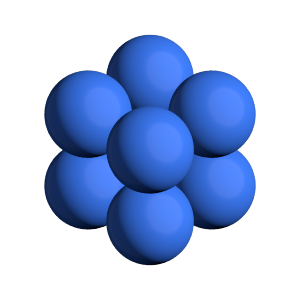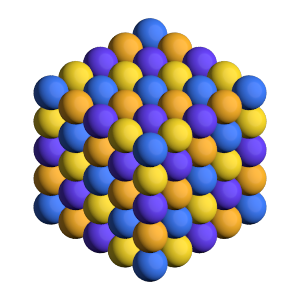Devices#
Each Scene is attached to a specific Device. The Device controls what hardware the ray tracing executes on. Scene implicitly creates a default Device when you do not specify one.
The default device#
The default device automatically selects GPU ray tracing if the gpu module is compiled and there is at least one gpu present in the system - otherwise it selects CPU ray tracing.
[1]:
import fresnel
device = fresnel.Device()
Query available execution modes#
The available_modes static variable lists which execution modes are available. This will vary based on compile time options and whether there is a GPU present in the system.
[2]:
print(fresnel.Device.available_modes)
['gpu', 'cpu', 'auto']
available_gpus lists the GPUs available for rendering in the system.
[3]:
for g in fresnel.Device.available_gpus:
print(g)
[0]: Quadro RTX 5000 48 SM_7.5 @ 1.82 GHz, 8198 MiB DRAM
Choose execution hardware#
Explicitly manage a Device to control what hardware the ray tracing executes on. Converting the device to a string provides a short summary of the device configuration.
[4]:
gpu = fresnel.Device(mode='gpu')
print(gpu)
<fresnel.Device: Enabled OptiX devices:
[0]: Quadro RTX 5000 48 SM_7.5 @ 1.82 GHz, 8198 MiB DRAM
>
[5]:
cpu = fresnel.Device(mode='cpu')
print(cpu)
<fresnel.Device: All available CPU threads>
Set n to specify how many CPU threads or GPUs to use in parallel. By default, a device will use all available CPU cores or GPUs in the system.
[6]:
cpu_limit = fresnel.Device(mode='cpu', n=6)
print(cpu_limit)
<fresnel.Device: 6 CPU threads>
Attach a scene to a device#
Each Scene must be attached to a device when created.
[7]:
scene_gpu = fresnel.Scene(device=gpu)
[8]:
scene_cpu = fresnel.Scene(device=cpu)
These two scenes have the same API, but different implementations.
[9]:
for scene in [scene_cpu, scene_gpu]:
geometry = fresnel.geometry.Sphere(scene, N=8, radius=1.0)
geometry.position[:] = [[1,1,1],
[1,1,-1],
[1,-1,1],
[1,-1,-1],
[-1,1,1],
[-1,1,-1],
[-1,-1,1],
[-1,-1,-1]]
geometry.material = fresnel.material.Material(color=fresnel.color.linear([0.25,0.5,1]))
scene.camera = fresnel.camera.Orthographic.fit(scene)
Rendered output is essentially identical from the two devices.
[10]:
fresnel.preview(scene_gpu, w=300, h=300)
[10]:

[11]:
fresnel.preview(scene_cpu, w=300, h=300)
[11]:

Memory consumption#
Each Device consumes memory by itself. When maintaining multiple scenes, attach them all to the same device to reduce memory consumption.
[12]:
import math
scene2_gpu = fresnel.Scene(device=gpu)
position = []
for k in range(5):
for i in range(5):
for j in range(5):
position.append([2*i, 2*j, 2*k])
geometry = fresnel.geometry.Sphere(scene2_gpu, position = position, radius=1.0)
geometry.color[::4] = fresnel.color.linear([0.25,0.5,1])
geometry.color[1::4] = fresnel.color.linear([1,0.714,0.169])
geometry.color[2::4] = fresnel.color.linear([0.42,0.267,1])
geometry.color[3::4] = fresnel.color.linear([1,0.874,0.169])
geometry.material = fresnel.material.Material(solid=0.0, primitive_color_mix=1.0)
scene2_gpu.camera = fresnel.camera.Orthographic.fit(scene2_gpu)
[13]:
fresnel.preview(scene2_gpu, w=300, h=300)
[13]:

This page was generated from a jupyter notebook. You can download and run the notebook locally from the fresnel-examples repository.